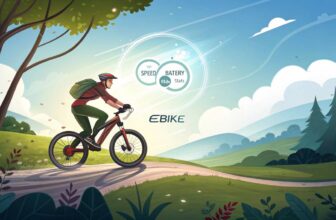Understanding Electric Bikes
Overview of Electric Bicycles
Let’s dive into the electric bicycle scene, where bikes come with a boost! Whether you’re breezing through city streets or savoring the scenic route, eBikes get you there with style and ease. They’re like your regular bikes, except someone went and added an electric motor to give you a little extra help when you’re pedaling. So, if you’ve ever stared down a steep hill and thought, “Not today!”—eBikes are your new best friend.
Nowadays, these snazzy bikes come equipped with pedal-assist systems that make the ride feel smoother than a jazz sax player on a Sunday afternoon. They sense how hard you’re pedaling and adjust the motor help accordingly.
Plus, many eBikes come with all the techy goodies like onboard computers, GPS, and more connectivity than a social media influencer. Get the scoop on how all these parts work harmoniously by checking our guide on electric bike controllers.
Market Growth Trends
The eBike scene isn’t just kicking into gear—it’s gaining some serious traction. Back in 2019, this market was clocking in at a cool $15.42 billion. Fast forward to 2025, and it’s expected to hit a rolling $23.75 billion. That’s a lot of pedals and motors! Big things are happening across Europe, Asia, and North America, as folks everywhere are grabbing onto this eco-friendly commute option like it’s the last cookie in the jar.
Check out the projected market boom for electric bicycles below:
| Year | Market Value (Billion USD) |
|---|---|
| 2019 | 15.42 |
| 2020 | 16.57 |
| 2021 | 17.80 |
| 2022 | 19.13 |
| 2023 | 20.57 |
| 2024 | 22.11 |
| 2025 | 23.75 |
What’s fueling this two-wheel takeover? Cities getting busier, more folks waking up to the eco shake and bake, and tech just getting cooler by the day. eBikes are the magic carpet rides of the transport world, slashing traffic jams and emissions in one pedal swoop.
These bikes play nice with everyone: city slickers love their speed and saving them cash, while seniors and the physically challenged enjoy newfound freedom (electric bikes for seniors). Fitness buffs balance their cardio without passing out halfway through the trail (ebike exercise benefits). Plus, delivery folks are making more stops, and spending less on gas (delivery ebike guide).
Along the road, look forward to seeing more mind-blowing innovations in bike designs, battery upgrades, and eco-friendly strides. Keep your finger on the pulse of eBikes by checking out the latest insights on ebike standards comparison and electric bike maintenance.
Essential Components
Electric bikes, or e-bikes for the cool kids, have some really important bits that make them extra fun to ride. Let’s chat about torque sensors, lithium-ion batteries, Insulated-Gate Bipolar Transistors (yes, it’s a mouthful), and Permanent-Magnet DC Motors. These gadgets are big players in ebike gear departments.
Torque Sensors and Pedal Assistance
Torque sensors are like the brains behind your smooth ride. They keep an eye on how hard you’re pedaling and adjust the motor’s push just right. No rocket starts or jerky stops—just pure biking bliss (SoCalCycling.com). Imagine them as your bike’s little helper, making sure you glide along effortlessly and maybe even get you up that hill without breaking a sweat.
Lithium-Ion Batteries
The heart of any e-bike is its battery, with lithium-ion being the popular kid in town. These batteries, usually tipping scales at around 6-7 pounds, are your ride-or-die, taking up to 1,000 rides to glory and back. They’re smart too—preventing any hot mess when charging or cycling (SoCalCycling.com). Want them to live longer? Peek at our electric bike battery care tips.
| Battery Type | Weight (lbs) | Ride Cycles |
|---|---|---|
| Lithium-Ion | 6-7 | Up to 1,000 |
| Lead-Acid | 20-30 | 300-500 |
| Nickel-Metal Hydride | 10-15 | 500-800 |
Figures from SoCalCycling.com
Insulated-Gate Bipolar Transistors (IGBTs)
Now, for the not-so-glam but super important tech: Insulated-Gate Bipolar Transistors. These guys are all about making sure power transfers smoothly so your bike doesn’t decide to turn into a fiery furnace (SoCalCycling.com). Let’s just say they make your e-bike run like a whisper in the wind.
Permanent-Magnet DC Motors
Let’s talk Permanent-Magnet DC Motors—think of them as the tiny yet mighty engines of e-bikes. Thanks to their nifty rare-earth magnets, these motors punch way above their weight class. Their tiny size and super strength make ’em perfect for electric bikes (SoCalCycling.com). Curious? Drop by our page on ebike motor types for a deeper look.
Getting to grips with what makes your electric bike tick not only gives you bragging rights but also helps you choose wisely whether you’re hitting the road for fun, saving cash on commutes, or zipping around to deliver those tasty takeouts.
Exploring Gear Systems
Derailleur Gear Systems
When it comes to electric bikes, derailleur setups are like the Swiss Army knives of the bike world. Ideal for tackling everything from potholed city streets to challenging trails, a derailleur system is all about flexibility and ease. This setup typically comes with a rear cassette and sometimes a front derailleur too, just to keep you guessing (Electric Bike Report).
It’s no wonder these gears are a hit with city slickers and weekend warriors alike. Maintenance? Piece of cake.
| Component | What’s It Do? |
|---|---|
| Rear Derailleur | Moves the chain across the back gears |
| Front Derailleur | (Optional) Juggles the chain over the front gears |
| Cassette | Collection of sprockets chillin’ on the back wheel |
Get the scoop on ebike classifications
Hub Gears and Their Pros/Cons
For those who like their bikes neat and tidy, hub gears are the way to go. Think of them as the tidy-up crew of gear systems, with everything neatly packed away in the rear hub. The Rohloff system, sporting 14 gears, is a prime example.
Perfect for those who want to journey far without the fuss of constant upkeep, especially great for eco-warriors and seniors who prefer smooth spins. But, heads up, they’re a bit on the hefty side and trickier to tinker with than their derailleur cousins (Electric Bike Report).
Pros:
- Shielded from mud and grit
- Almost no need to fuss
- Built to last
Cons:
- A tad weighty
- More fiddly to repair
Check out more on electric bike upkeep
Electronic and Wireless Shifting Systems
Picture seamless gear shifts at the touch of a button — that’s electronic and wireless shifting for you. Kiss goodbye to the days of sticky cables and gear-hopping tantrums (Electric Bike Report). By converting shifts into electronic signals, these systems are making waves among speedy couriers and laid-back cruisers alike.
| System Type | Perks |
|---|---|
| Electronic Shifting | Lightning-fast, accurate gear swaps |
| Wireless Shifting | No cables, no worries |
Discover more about ebike motor magic
Continuously Variable Transmission (CVT)
Continuously Variable Transmission, or CVT, feels like ghost shifting. No jarring jumps, just smooth sailing with infinite gear tweaks to match your pace and mood. Ideal for those navigating cityscapes or facing physical challenges head-on. Sure, they might sip a bit more juice from the battery — nothing the e-assist won’t cover (Electric Bike Report).
| Feature | What It’s All About |
|---|---|
| Infinite Gear Ratios | Limitless shifts, always in Goldilocks zone |
| Simple Concept | Brain-friendly and effortless to ride |
| E-bike Friendly | Extra weight? Let the motor handle it |
| Battery Impact | Can trim range a smidge, but hey, that’s what motors do |
Learn about squeezing extra miles from your battery
Brake Systems for Safety
Riding an electric bike can be a blast, but staying safe is the top priority, especially when it comes to having the right brakes. Let’s look into what makes these brake systems tick and how they keep you out of trouble.
Hydraulic Disc Brakes
When it comes to stopping your e-bike with ease, hydraulic disc brakes are the crowd favorite. They use a fancy-fluid system, sorta like high-tech plumbing for bikes, to offer top-notch stopping power and control.
| Feature | What It Means |
|---|---|
| Stopping Power | Thanks to that fluid system, they halt your bike right fast |
| Precision | Gives you that “in the zone” feeling every time you brake |
| Heat Dissipation | Stays chill on long rides, avoiding the burnout |
| Maintenance | Not a hassle — barely needs your attention |
| Reliability | Dependable rain or shine, even in rougher rides |
If you’re cruising on a Himiway electric bike, you’re likely already rocking these cool brakes. For more in-depth bike brake knowledge, hit up our electric bike brakes page.
Mechanical Disc Brakes vs. Hydraulic
Now, while hydraulic brakes might be king, mechanical disc brakes aren’t far behind. They’re the budget-friendly option — they won’t burn a hole in your pocket.
| Feature | Mechanical Disc Brakes | Hydraulic Disc Brakes |
|---|---|---|
| Operation | Uses sturdy cables | Relies on that fluid mojo |
| Maintenance | Needs some regular TLC | Just set it and forget it |
| Performance | Works fine, but can’t beat hydraulic when in a pinch | Shines especially in rough & tumble rides |
| Cost | Wallet-friendly | Bit pricey but worth it |
Rim brakes exist too, mostly for those lightly speeding bikes — although they tend to slip and slide a bit when wet.
Importance of Motor Cutoff Switches
When you slam the brakes, the last thing you want is your bike’s motor still shooting you forward. Cue the motor cutoff switch — it cuts the motor as you brake, letting you stay boss on the bike.
| Safety Feature | What It Does |
|---|---|
| Motor Cutoff Switch | Kills the motor quick, keeps you safe and in control |
Dive into more goodies on e-bike safety by checking out ebike safety features.
Maintenance Tips for Hydraulic Brakes
Keeping those hydraulic brakes working like new? Easy peasy. Here’s some simple keep-it-running advice:
- Give your brakes a good cleaning when they start looking grimy
- Swap out worn-down brake pads, don’t wait till they’re screaming for help
- Bleed the brakes if you feel air bubbles slumping the power
- Check all parts now and then so nothing sneaks up on you, breaking your fun
A regular maintenance routine is your brake’s best friend, keeping any hiccups at bay. For all that nitty-gritty about keeping your e-bike tip-top, peruse our electric bike maintenance section.
There’s a whole lot more to learn about staying safe and understanding the different brakes and tips for e-bikes in our ebike maintenance and safety guide.
Evolution of Electric Bikes
Historical Development
Once upon a time in the late 1800s, electric bikes (eBikes) were just a glint in an inventor’s eye. It all started in 1895 when Ogden Bolton Jr. dreamt up a curious contraption—a bike with a hub motor tucked in the rear wheel and a battery perched on the down tube. Fun fact: this early eBike was pedal-free! But power-starved, its 10-volt battery would run out of juice faster than you could say “bike ride”
Then bingo! In 1897, another clever cookie, Hosea W. Libbey from Boston, rolled out an electric bike sporting a “double electric motor.” This was the granddaddy of modern eBikes, paving the way for further clever tweaks and upgrades
| Year | Inventor | Innovation |
|---|---|---|
| 1895 | Ogden Bolton Jr. | Hub motor & battery on down tube, no pedals |
| 1897 | Hosea W. Libbey | Introduced double electric motor |
Advancements in Battery Technology
Over the years, the beating heart of electric bikes—batteries—has seen some serious upgrades. Back in the day, lead-acid batteries were the go-to. They worked, but boy, they were heavy and didn’t go very far. Enter lithium-ion batteries—the game-changer! These snazzy power packs are light, punch above their weight in energy output, and keep you going much longer on a single charge (Michael Blast).
Here’s why they’re the apple of the modern eBike rider’s eye:
- Speedier rides
- Extended miles
- All-around better for zipping around town
Want your battery to last its best? Check out our handy guides on electric bike battery care and how to charge your eBike.
| Battery Type | Weight | Energy Density | Ride Convenience |
|---|---|---|---|
| Lead-Acid | Heavy | Low | Limited |
| Lithium-Ion | Light | High | Much improved |
Integration of Digital Technology
Fast forward to today, eBikes have hitched a ride aboard the tech express. They’ve gotten lighter, faster, and a lot smarter. With pedal-assist technology, your bike now senses when you’re pedaling and offers a friendly motorized nudge—making riding a dream (Michael Blast).
And they don’t just stop there; they’ve become little tech marvels with:
- Onboard computer systems
- GPS to steer you right
- A whole bag of connectivity tricks
Thanks to these bells and whistles, you can fiddle with your ride settings, keep an eye on your battery, and get all the info you need with just a button press. Curious about these digital befriends? Scoot over to our guides on ebike display settings and ebike troubleshooting.
| Feature | Why It Rocks |
|---|---|
| Onboard Computers | More control, better rides |
| GPS Navigation | Get lost? Not with this! |
| Connectivity | Turns your bike into a smart friend |
The road for electric bikes looks mighty exciting, serving everyone from city commuters, and eco-warriors, to folks keen on keeping fit. With tech marching on, eBike fans have plenty to look forward to.
Hungry for more info? Check out our resources on ebike motor types and electric bike brakes, and get ready to ride with confidence!
Motor Types
Picking the right electric bike (eBike) motor can feel like finding your soulmate—it’s gotta be a perfect match! The motor is the heart of an eBike, shaping its power, balance, and overall ride experience. Let’s give you the lowdown on the most common motor types: hub motors placed either at the back or the front, mid-drive motors, and the showdown between geared and gearless hub motors.
Hub Motors: Rear vs. Front
Hub motors live inside the wheel hub and are a crowd favorite among eBike folks. They’re tough, fairly easy to maintain, and add oomph to your ride. Where you slap that motor—back wheel or front—can change how your ride feels.
Rear Hub Motors has your back—literally! They’re like trusty workhorses, pushing you along like you’re riding a traditional bike. With the motor weight tucked back there, you get better traction and power. These bad boys pack more punch than their front wheel cousins.
Front Hub Motors hang out in the front wheel, yanking you forward. It’s a different kind of thrill! But, heads up, the balance might get tricky, especially when you’re lugging a lot or hitting rocky roads. They’re a breeze to install and popular for those cool DIY eBike conversion projects.
| Motor Placement | Pros | Cons |
|---|---|---|
| Rear Hub Motor | Great balance, More powerful | Costs a bit more |
| Front Hub Motor | Easy set-up, Friendly on the wallet | Messes with balance sometimes, Not a fan of bumpy rides |
Mid-Drive Motors and Their Benefits
Mid-drive motors are like the center of gravity superheroes for eBikes, tucked away near the pedals. They’re champs in all kinds of riding conditions, from breezy trails to tough hills.
By teaming up with your bike’s gears, mid-drive motors deliver power smoothly, making you feel like you’re born to ride! They shine on rolling hills and uneven paths. While they do come with a steeper price tag, many folks swear by them for their even weight spread and sleek integration.
Why Mid-Drive Rocks:
- Smooth, balanced action.
- Uses power like a pro.
- Handles hills like a mountain goat.
To see how they stack up against others, swing by our mid-drive vs. hub motor ebike guide.
Geared vs. Gearless Hub Motors
Time to split the hub motors into two teams: geared and gearless. Each has its own perks and quirks.
Geared Hub Motors have little gears inside to amp up torque, which is great for hauling stuff or conquering climbs. They’re compact and light, but those gears need some love now and then.
Gearless Hub Motors (or direct drive) keep it simple with fewer moving parts, making them tougher and less needy. They’re big and heavier but can zip along faster and give you a dreamy smooth ride on straightaways.
| Motor Type | Pros | Cons |
|---|---|---|
| Geared Hub Motor | Great low-speed torque, Light | Needs a little more upkeep |
| Gearless Hub Motor | Tough, Smooth operator | Bigger, Weighs more |
Grasping the strengths and downsides of each motor type is key to picking your perfect ride. For a deeper dive, check out our ebike motor types guide.
As you browse through all these motor choices, you’ll figure out the perfect eBike for cruising to work, keeping fit, or just goofing around. Picking the right motor can crank up the fun, comfort, and efficiency of your eBike adventures.
Battery Technology
Battery Size and Range
The battery in your e-bike is like the heart, pumping energy and deciding how far and fast you’ll go. Most e-bike batteries pack multiple lithium-ion cells, with their oomph measured in watt-hours (Wh). The bigger the Wh, the longer the ride. Take a 500Wh battery—it’s like a road tripper compared to the 300Wh, which is more for city cruising.
Here’s how battery sizes typically stack up against distance:
| Battery Size (Wh) | Estimated Range (miles) |
|---|---|
| 300Wh | 20 – 30 |
| 400Wh | 25 – 50 |
| 500Wh | 30 – 60 |
| 750Wh | 40 – 80 |
But don’t bank on just the numbers. The gulp of juice depends on stuff like how often you pedal, your weight, and if you’re climbing hills or bowling down roads. Check here for a deeper dive into how all this shakes out.
Importance of Battery Placement
Where you plonk the battery on your bike can really change the game—it’s about more than just looks. The usual suspects for battery spots are the downtube, hidden inside the frame, or hanging out on a rear carrier. Each has its ups and downs:
- Downtube: Hits the sweet spot for even weight and great handling—especially with mid-drive motors.
- Integrated: Tucked away for those who like a slick look and extra weather protection, but good luck getting to it quickly.
- Rear Carrier: Easy to get your mitts on and maybe gives you extra space to lug stuff, though it might tip the scales off balance.
Battery location reshuffles weight and handling, so it matters. For more tips on taking care of your bike’s battery, head over to our battery care guide.
Role of Electric Bike Controllers
Think of the electric bike controller as the puppet master, reigning in the power from the battery and making sure everything runs smoothly. It’s in charge of making your ride feel like a dream:
- Regulating Power Flow: Make sure your motor gets just the right jolt from the battery.
- Managing Pedal Assist Levels: Tunes the motor help based on how much you’re sweating it out.
- Ensuring Safety: Cuts the juice when you hit the brakes or something’s not quite right.
Pick the right controller, and you’re setting yourself up for a sweet ride. Learn more about mastering these settings in our controller settings section.
Getting a handle on these building blocks of e-bike battery tech is gonna arm you with the know-how you need when picking or pimping out your ride. Whether you’re all in for a DIY ebike conversion or hunting the best bargain electric wheels, knowing your battery choices and placements are must-dos for the ultimate biking buzz.
Enhancing Riding Experience
E-Bike Displays and Information
E-bike displays are like your biking buddy with a screen, dishing out all the juicy, real-time details about your ride. Nestled right on the handlebars, these little tech wonders spill the beans on your speed, battery juice left, assist mode, and how far you’ve pedaled. Fancy displays even throw in stats like estimated range, power output (in watts, if you want to feel like a scientist), or cadence—which is just a fancy way of saying how fast you’re pedaling. Want the full lowdown on these tech settings? Check out our complete guide on ebike display settings.
| Feature | Basic Displays | Advanced Displays |
|---|---|---|
| Speed | ✓ | ✓ |
| Battery Level | ✓ | ✓ |
| Assist Mode | ✓ | ✓ |
| Distance Traveled | ✓ | ✓ |
| Estimated Range | ✓ | |
| Power Output | ✓ | |
| Cadence | ✓ |
If you’re curious about how these features can jazz up your ride, don’t miss our articles on electric bikes for seniors or the ebike commuting guide.
Throttle Systems for Quick Starts
Throttle systems are like that secret weapon you didn’t know you needed—perfect for when you wanna zoom off at the lights without breaking a sweat or tackle those tricky bits without shifting gears. Think of it as a turbo button that makes riding a breeze (Really Good Ebikes). Curious about the inner workings of these motor masters? Dive into our guide on ebike motor types.
Optimizing Battery Capacity for Range
When it comes to covering some serious ground on an e-bike, the size of your battery pack is the star of the show. Bigger batteries = more miles. It’s a simple equation. Other elements like how much help you get from the pedals and the kind of battery you’re packing also chip in to determine how far you’ll go (Bolt Blog). For those planning epic journeys, go for e-bikes with high battery capacity to get the most bang for your buck.
| Battery Capacity (Wh) | Approximate Range (Miles) |
|---|---|
| 250 | 15 – 30 |
| 500 | 30 – 60 |
| 750 | 45 – 75 |
Got range on your mind? Learn more in our articles on ebike range factors and electric bike battery care.
For more juicy tips and tricks on pimping your ride and getting your head around other e-bike parts, such as ebike gear systems, these nuggets will maximize your e-biking fun.




